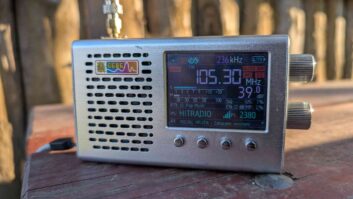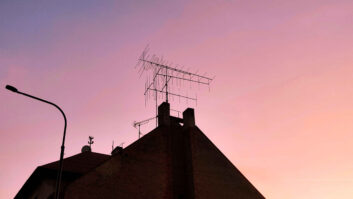PRODUCT CAPSULE
(click thumbnail)
Sony MZ-M200
Hi-MD MiniDisc Recorder
THUMBS UP:
The most evolved Sony Walkman MD
Flexible and adaptable
USB2 transfer
Long battery life
High capacity
Sturdy
THUMBS DOWN:
Mini jack for input and output
PRICE: $439.95
CONTACT:http://www.sony.com or Sony dealers
When I mentioned to a co-worker that I was going to have a look at Sony’s new MiniDisc offering, the MZ-M200, he looked at me with a grimace and let me know exactly how he felt about the previous generation of MiniDisc. Apparently, some folks had misgivings about recent MD products and might have given up on MD as a dead technology.
With MP3 players and Flash recorders as common as Kleenex tissues, why would anyone want to use the seemingly anachronistic MD format anyway?
We know there are strengths and weaknesses to any format; Sony has given cynics a reason to rethink the MiniDisc format with the MZ-M200.
The MZ- M200 is a compact digital audio recorder/player that can play files downloaded in LinearPCM, Sony’s ATRAC (including ATRAC3 & ATRAC3plus) or MP3 format. It features the ability to record or transfer legacy recordings onto a low-cost (less than $10) 1 GB Hi-MD MiniDisc. The 1GB MiniDisc theoretically can store up to 675 songs, 45 hours of music (or 13 hours of music on a standard MD media). The 1 GB Hi-MD media also can be used to store 1 GB of data as well.
Users of legacy MD devices will enjoy the MZ-M200’s ergonomics. There’s no doubt Sony put a lot of thought into how this recorder will be used in a professional environment. Little about the MZ- M200 resembles earlier MD recorders, except perhaps the size. Pocket-sized as expected, the MZ-M200’s display has been moved to the top of the unit, making it perfectly readable in one’s shirt pocket for instance.
If placed flat on a counter, such as in a recording studio or newsroom, the slightly angled display allows for easy reading as well. Used like this, Sony has added four small runner feet to prevent it from sliding around. It’s almost as if someone ran your full-size MD player too long in the dryer. In your hands, the rubberized surface keeps it from slipping away.
The MZ-M200 feels like a piece of professional gear as well. Although small, all buttons are spaced enough for even the clumsiest of fingers, and the solid metal chassis rivals that of most MP3 devices around. The Record switch is simple and not likely to be accidentally triggered. Stop and Pause buttons are clear and accessed easily. On the side, a jog lever — again, difficult to unintentionally engage — steps you through the tracks on the disk. The multifunction Display/Menu button gives easy access to the device’s many features.
The feel of the M200’s controls is solid and intentional. There are no sloppy switches or soft gooey pushbuttons. Input and output jacks remain standard fare (mini), the difference here being the addition of a USB port greatly enhancing upload capability to a PC. The port also functions economically as a DC power input. The MZ- M200 also can function as an external PC drive using the USB 2 port as well.
Back to basics
Sony has brought back many of the earlier MD features that were coveted but unfortunately dropped in previous incarnations. For instance, the ability to use regular MD disks has returned, good news for those who have amassed an archive of standard MD recordings.
The MZ-M200 can use these disks for recording should one have a stash of blanks kicking around, although at a reduced capacity as compared to the Hi-MD’s capabilities (using the line-in jack, you can transfer old MD format material to the newer high-capacity discs, minimizing your library space).
If you take a moment to set the time and date on your MZ-M200, it will time- and date-stamp your recordings. This certainly could be a useful feature for those interested in archiving interviews, for example. The ability to change playback speeds of recordings is back in the guise of the Digital Pitch Control feature, useful when replaying speech recordings and hunting for certain passages.
The player’s headphone jack is switchable as a line-out jack, relieving the necessity of having to shuttle volume levels all over the place to facilitate other playback equipment you might wish to connect to.
If losing your record settings caused you grief with past MD recorders, the MZ-M200 remembers these settings for you, even for a short duration after removing the Li-ion battery. For use in the recording studio, where so many computers are of the MAC variety, Sony has made the MZ- M200 MAC-compatible. In particular, this means Sony supplies Hi-MD music transfer software, which comes standard with the MZ-M200.
Sonic Stage is Sony’s WIN PC program, which enhances the transfer and conversion capabilities of the MZ-M200.With it you can shuttle audio back and forth between the recorder and your PC’s hard drive, convert files for playback purposes, burn CDs or use the MZ- M200 as an external drive. As mentioned, the recorder connects to your PC via the supplied USB2 cable. The software display is reminiscent of an FTP transfer program and user-friendly. A “Simple Mode” program allows you to record tracks to an MD disc from an audio CD in your computer’s D: drive without storing it first on the hard drive.
Sonic Stage is a multifeature program designed to manage your PC audio needs, whether you are retrieving sound from the Internet, MP3 recorder, MZ-M200 or a finished CD. You can organize your library, and of course move audio to and from the recorder itself; Hi-MD recordings can be saved in the WAV format using Sonic Stage.
Crisp, cool display
I would be remiss if I neglected to mention the EL display. It is rather cool and heads above earlier portable MiniDisc products. As I stated, it is positioned in a way that makes the recorder a good fit for pocket or tabletop operation. But wait until you see this window.
The characters, although small by necessity, are brightly displayed and crisp, for lack of a better word. During playback you can toggle though various descriptions of what you are hearing: group number, number of tracks remaining along with current track, the record time and date, even a somewhat cheesy but definitely fun pair of spectrum analyzer displays.
Even without reading the manual (as many of us are wont not to do), I was able to navigate about the MZ-M200 intuitively without much strain on the cerebellum.
Sony hasn’t forgotten that despite the serious uses to which this little recorder can be applied, we like to have a little fun on the way. There is a remote control included that provides its own LCD display. It is simple to jump through the menu to select record modes, levels, mic AGC or sensitivity, mark time or activate any of the other features.
Okay, so we have the ability to select various record modes (of various quality), move audio about to a PC and store large quantities of sound on the MZ-M200. But that “moving parts” issue is always in the back of my mind. You do indeed have moving parts, which of course are subject to failure at some point; but you also have a high-capacity storage medium — the Hi-MD disc — which is removable from the recorder, meaning that in the event of device failure there is a good chance your files will be safe.
As for the price, a professional using the MZ- M200 might consider buying more than one so as to have a backup unit.
One aspect I do not like about MD recorders has been the mini jacks used for the mic/line input and headphone/line output. Although understandable to a degree in a device of this size, they simply do not hold up to repeated stress over time. I do not consider these adequate for professional use unless Sony has come up with a way these can be easily field-serviced. Unfortunately, this Achilles Heel has contributed to many folks considering the MD recorder “disposable” devices.
Finally, the MZ-M200 comes with some useful accessories, such as an AC power adapter designed to work with the USB cable; a remote control; a set of ear buds; and a compact stereo microphone, which is actually a lot of fun for field recordings. A Lithium-Ion battery provides 5–10 hours of record time and 8 to 19 hours of playback time depending on the format.
It is beyond the scope of this article to go into the details regarding the different formats and features of which this portable MD recorder is capable. Suffice it to say, it was designed for the broadcast or studio professional. Those looking for a way to archive high-quality sound will find the many aspects of this recorder attractive. Those wishing to archive music such as home studio recordings or live concerts, i.e. in the uncompressed LinearPCM mode, also will discover much to like about this palm-sized wonder.








